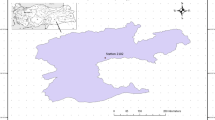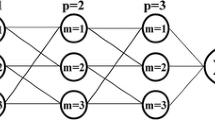Abstract
A reliable prediction of dispersion coefficient can provide valuable information for environmental scientists and river engineers as well. The main objective of this study is to apply intelligence techniques for predicting longitudinal dispersion coefficient in rivers. In this regard, artificial neural network (ANN) models were developed. Four different metaheuristic algorithms including genetic algorithm (GA), imperialist competitive algorithm (ICA), bee algorithm (BA) and cuckoo search (CS) algorithm were employed to train the ANN models. The results obtained through the optimization algorithms were compared with the Levenberg–Marquardt (LM) algorithm (conventional algorithm for training ANN). Overall, a relatively high correlation between measured and predicted values of dispersion coefficient was observed when the ANN models trained with the optimization algorithms. This study demonstrates that the metaheuristic algorithms can be successfully applied to make an improvement on the performance of the conventional ANN models. Also, the CS, ICA and BA algorithms remarkably outperform the GA and LM algorithms to train the ANN model. The results show superiority of the performance of the proposed model over the previous equations in terms of DR, R 2 and RMSE.






Similar content being viewed by others
References
Ardalan Z, Karimi S, Poursabzi O, Naderi B (2015) A novel imperialist competitive algorithm for generalized traveling salesman problems. Appl Soft Comput 26:546–555
Asadnia M, Chua LH, Qin X, Talei A (2013) Improved particle swarm optimization-based artificial neural network for rainfall-runoff modeling. J Hydrol Eng 19:1320–1329
Atashpaz-Gargari E, Lucas C (2007) Imperialist competitive algorithm: an algorithm for optimization inspired by imperialistic competition. In: Evolutionary computation, 2007. CEC 2007. IEEE Congress on. IEEE, pp 4661–4667
Azamathulla HM, Wu F-C (2011) Support vector machine approach for longitudinal dispersion coefficients in natural streams. Appl Soft Comput 11:2902–2905
Bishop CM (1995) Neural networks for pattern recognition. Oxford University Press, Oxford
Chau K (2004) River stage forecasting with particle swarm optimization. In: International Conference on Industrial, Engineering and Other Applications of Applied Intelligent Systems. Springer, Heidelberg, pp 1166–1173
Chen Y-h, Chang F-J (2009) Evolutionary artificial neural networks for hydrological systems forecasting. J Hydrol 367:125–137
Chen X, Chau K, Busari A (2015) A comparative study of population-based optimization algorithms for downstream river flow forecasting by a hybrid neural network model. Eng Appl Artif Intell 46:258–268
Cheng C-T, Wang W-C, Xu D-M, Chau K (2008) Optimizing hydropower reservoir operation using hybrid genetic algorithm and chaos. Water Resour Manag 22:895–909
Cheng C-t, Niu W-j, Feng Z-k, Shen J-j, Chau K-w (2015) Daily reservoir runoff forecasting method using artificial neural network based on quantum-behaved particle swarm optimization. Water 7:4232–4246
Danandeh Mehr A, Kahya E, Şahin A, Nazemosadat M (2015) Successive-station monthly streamflow prediction using different artificial neural network algorithms. Int J Environ Sci Technol 12:2191–2200
Disley T, Gharabaghi B, Mahboubi A, McBean E (2015) Predictive equation for longitudinal dispersion coefficient. Hydrol Process 29:161–172
Düğenci M, Aydemir A, Esen İ, Aydın ME (2015) Creep modelling of polypropylenes using artificial neural networks trained with Bee algorithms. Eng Appl Artif Intell 45:71–79
Elder J (1959) The dispersion of marked fluid in turbulent shear flow. J Fluid Mech 5:544–560
Etemad-Shahidi A, Taghipour M (2012) Predicting longitudinal dispersion coefficient in natural streams using M5′ model tree. J Hydraul Eng 138(6):542–554
Fischer HB, List JE, Koh CR, Imberger J, Brooks NH (1979) Mixing in inland and coastal waters. Elsevier, Amsterdam
Gandomi AH, Yang X-S, Alavi AH (2013) Cuckoo search algorithm: a metaheuristic approach to solve structural optimization problems. Eng Comput 29:17–35
Goldberg DE (1989) Genetic algorithm in search, optimization and machine learning. Addison Wesley Publishing Company, Reading, pp 1–9
Hagan MT, Menhaj MB (1994) Training feedforward networks with the Marquardt algorithm. IEEE Trans Neural Netw 5:989–993
Ham FM, Kostanic I (2000) Principles of neurocomputing for science and engineering. McGraw-Hill Higher Education, New York
Jafarzadeh A, Pal M, Servati M, FazeliFard M, Ghorbani M (2016) Comparative analysis of support vector machine and artificial neural network models for soil cation exchange capacity prediction. Int J Environ Sci Technol 13:87–96
Kashefipour SM, Falconer RA (2002) Longitudinal dispersion coefficients in natural channels. Water Res 36:1596–1608
Kaveh A, Talatahari S (2010) Optimum design of skeletal structures using imperialist competitive algorithm. Comput Struct 88:1220–1229
Kayarvizhy N, Kanmani S, Uthariaraj R (2013) Improving Fault prediction using ANN-PSO in object oriented systems. Int J Comput Appl 73:0975–8887
Li X, Liu H, Yin M (2013) Differential evolution for prediction of longitudinal dispersion coefficients in natural streams. Water Resour Manag 27:5245–5260
Liu H (1977) Predicting dispersion coefficient of streams. J Environ Eng Div 103:59–69
Lucas C, Nasiri-Gheidari Z, Tootoonchian F (2010) Application of an imperialist competitive algorithm to the design of a linear induction motor. Energy Convers Manag 51:1407–1411
Najafzadeh M, Tafarojnoruz A (2016) Evaluation of neuro-fuzzy GMDH-based particle swarm optimization to predict longitudinal dispersion coefficient in rivers. Environ Earth Sci 75:1–12
Noori R, Karbassi A, Farokhnia A, Dehghani M (2009) Predicting the longitudinal dispersion coefficient using support vector machine and adaptive neuro-fuzzy inference system techniques. Environ Eng Sci 26:1503–1510
Noori R, Deng Z, Kiaghadi A, Kachoosangi FT (2015) How reliable are ANN, ANFIS, and SVM techniques for predicting longitudinal dispersion coefficient in natural rivers? J Hydraul Eng 142:04015039
Pham D, Ghanbarzadeh A, Koc E, Otri S, Rahim S, Zaidi M (2005) The bees algorithm. Technical note Manufacturing Engineering Centre, Cardiff University, UK, pp 1–57
Sahay RR (2011) Prediction of longitudinal dispersion coefficients in natural rivers using artificial neural network. Environ Fluid Mech 11:247–261
Sahay R, Dutta S (2009) Prediction of longitudinal dispersion coefficients in natural rivers using genetic algorithm. Hydrol Res 40(6):544–552
Seo IW, Cheong TS (1998) Predicting longitudinal dispersion coefficient in natural streams. J Hydraul Eng 124:25–32
Tayfur G (2009) GA-optimized model predicts dispersion coefficient in natural channels. Hydrol Res 40(1):65–78
Tayfur G, Singh VP (2005) Predicting longitudinal dispersion coefficient in natural streams by artificial neural network. J Hydraul Eng 131:991–1000
Taylor G (1953) Dispersion of soluble matter in solvent flowing slowly through a tube. In: Proceedings of the Royal Society of London A: Mathematical, Physical and Engineering Sciences, vol 1137. The Royal Society, pp 186–203
Taylor G (1954) The dispersion of matter in turbulent flow through a pipe. In: Proceedings of the Royal Society of London A: Mathematical, Physical and Engineering Sciences, vol 1155. The Royal Society, pp 446–468
Tutmez B, Yuceer M (2013) Regression Kriging analysis for longitudinal dispersion coefficient. Water Resour Manag 27:3307–3318
Wang W-C, Chau K-W, Cheng C-T, Qiu L (2009) A comparison of performance of several artificial intelligence methods for forecasting monthly discharge time series. J Hydrol 374:294–306
Wang W-C, Cheng C-T, Chau K-W, Xu D-M (2012) Calibration of Xinanjiang model parameters using hybrid genetic algorithm based fuzzy optimal model. J Hydroinform 14:784–799
Xiao Z, Liang S, Wang J, Chen P, Yin X, Zhang L, Song J (2014) Use of general regression neural networks for generating the GLASS leaf area index product from time-series MODIS surface reflectance. IEEE Trans Geosci Remote Sens 52:209–223
Yang X-S, Deb S (2009) Cuckoo search via Lévy flights. In: Nature and biologically inspired computing, 2009. NaBIC 2009. World Congress on, 2009. IEEE, pp 210–214
Yildiz AR (2013) Cuckoo search algorithm for the selection of optimal machining parameters in milling operations. Int J Adv Manuf Technol 64:55–61
Zeng Y, Huai W (2014) Estimation of longitudinal dispersion coefficient in rivers. J Hydro-environ Res 8:2–8
Zhang J-R, Zhang J, Lok T-M, Lyu MR (2007) A hybrid particle swarm optimization–back-propagation algorithm for feedforward neural network training. Appl Math Comput 185:1026–1037
Acknowledgments
We thank Ali Afghantoloee for assistance with the training algorithms.
Author information
Authors and Affiliations
Corresponding author
Electronic supplementary material
Below is the link to the electronic supplementary material.
Rights and permissions
About this article
Cite this article
Alizadeh, M.J., Shabani, A. & Kavianpour, M.R. Predicting longitudinal dispersion coefficient using ANN with metaheuristic training algorithms. Int. J. Environ. Sci. Technol. 14, 2399–2410 (2017). https://doi.org/10.1007/s13762-017-1307-1
Received:
Revised:
Accepted:
Published:
Issue Date:
DOI: https://doi.org/10.1007/s13762-017-1307-1




